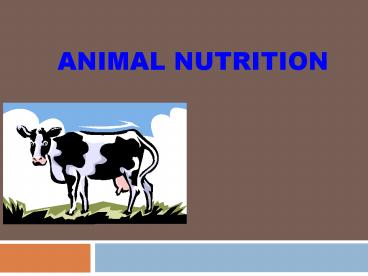Animal Nutrition - PowerPoint PPT Presentation
1 / 29
Title:
Animal Nutrition
Description:
ANIMAL NUTRITION * * What is Nutrition! Nutrition is the science of dealing with the utilization of food by the body processes which transforms food into body tissues ... – PowerPoint PPT presentation
Number of Views:342
Avg rating:3.0/5.0
Title: Animal Nutrition
1
Animal Nutrition
2
What is Nutrition!
Nutrition is the science of dealing with the
utilization of food by the body processes which
transforms food into body tissues and energy.
3
Why is Nutrition Important!
To obtain and utilize surplus or unusable feed
stuffs And convert them to desirable products
such as meat, milk, eggs, fiber and work.
4
What is a Nutrient?
A single class of food or group of like foods
that aids in the support of life and makes it
possible for animals to grow or provide energy
for physiological processes.
5
Digestible Nutrient
The portion of the nutrient which may be broken
down (digested) and absorbed and used by the
body.
6
The Six Nutrients Needed
- Protein
- Carbohydrates
- Fats
- Minerals
- Vitamins
- Water
7
Proteins
- Needed for growth and repair
- Helps form muscles, internal organs, skin,
hair,wool, feathers, hoofs and horns - Contain carbon, hydrogen, oxygen and nitrogen
8
Examples of Proteins
- Meat and Bone Meal
- Fish Meal
- Soybean Meal
- Cottonseed Meal
- Dried Skim Milk
- Amino Acids
9
Carbohydrates
- Furnish energy for body functions, growth
- and reproduction
- The largest part of the animals food supply
- and usually the fibrous part of the diet
- Include sugars, starch and cellulose
- Are made of carbon, oxygen and hydrogen
10
Fats
- Furnish a concentrated source of energy, up to
- 2.25 times as much energy as carbohydrates do
- Form cholesterol, steroids and other body
- compounds
- Found in every cell in the body
- Affect the condition of skin and hair
- Are made of carbon, oxygen and hydrogen, but
- contain much larger proportions of carbon and
- hydrogen than carbohydrates do
- They also provide energy reserves, protection
for - vital organs, and they insulate the body
11
Minerals
- Primarily found in bones and teeth
- Important in blood for the carrying of
- oxygen
- Regulates heartbeat with potassium,
- sodium
- and calcium
Example Calcium Formation rocks
12
VITAMINS
- Are only needed in small amounts
- Are essential for life and health
- Provide a defense against disease, promote growth
and reproduction - Contribute to the general health of the animal
13
WATER
Accounts for 70 or more of the composition of
most plants and animals
14
FEED CLASSIFICATIONS
Roughages Concentrates Supplements
15
ROUGHAGES
- High in Fiber
- Relatively low in digestible nutrients
- Examples
- Alfalfa
- Clover
- Soybean
- Oat hay
- Corn Silage
16
Concentrates
- Low in fiber
- High in digestible nutrients
- Examples
- Corn
- Cottonseed
- Barley
- Oats
- Sorghum
17
Supplements
- Supplements are extras that supply the body with
additional nutrients. - Some of the supplements are minerals salt,
copper, iodine and iron - Vitamin A and D are also very important to
ruminant animals
Salt
Iron
Copper
18
Review.
- What is nutrition?
- the science of dealing with the utilization of
Food by the body processes which transform food
into body tissue and activities. - Why is Nutrition important?
- Utilizes unusable feed stuffs and converts them
to desirable products such as meat, milk and
eggs. - What are the six nutrients needed?
- Protein, carbohydrates, fats, minerals, vitamins
and water
19
Digestive System
20
Digestive System
- Large complex molecules broken down into simpler
molecules - Long tube beginning with mouth and ending with
the anus
21
Digestive Systems
- Man Pig have a simple stomach with an extensive
intestinal system - Ruminants have a complex stomach with a simpler
intestinal system - Horses Rabbits have a simple stomach with an
extensive intestinal system and an enlarged cecum
22
Digestive System
- Mouth Prehension tool (grasps food)
- Salivary Glands secrete juices containing enzymes
(digest food) - Chewing food breaks down also
- Esophagus muscular tube that connects mouth to
stomach - Peristaltic Movement
- sequential contraction of ring like muscles
- Reverse Peristalsis blowing chunks
23
Simple Stomach
- Muscular contractions break down food
- Enzymes break down food
- Gastric proteins
- Liver Pancreatic fats
24
(No Transcript)
25
Ruminant Stomach
- Stomach occupies 3/4 of abdominal cavity, mostly
on the left side - Rumen (paunch) 80 of stomach, lighter food
collects here - microbes digest cellulose
- lots of water
- Reticulum (hardware stomach) 5 of stomach,
heavy foreign items are trapped here
26
Ruminant Stomach
- Omasum (many plies) 8 of stomach, absorbs water
- Abomasum (true stomach) 8 of stomach, typical
enzyme activity - Rumination regurgitation, rechewing of food
27
(No Transcript)
28
Digestive System
- Small Intestine long coiled tube connecting
stomach to large intestine - rest of the digestion and absorbtion takes place
here - surface covered with villi (surface area)
- Large Intestine Cecum, colon, rectum
- absorbs water (makes feces more solid)
- some vitamins minerals absorbed here
- Cecal Fermenters (Horse) similar to rumen
29
Digestive System
- Accessory organs
- Pancreas secretes enzymes to break down fat
- Liver (largest internal organ) secretes bile,
which digests fats - also stores iron































